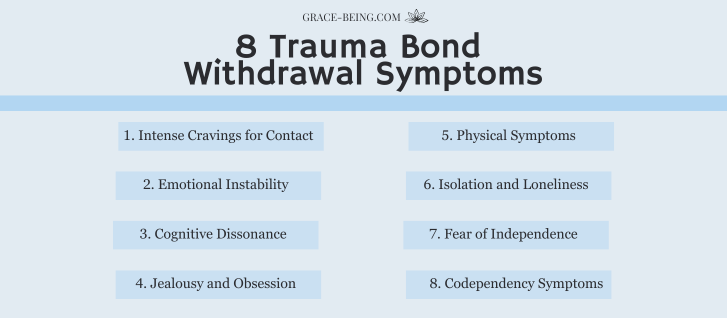Understanding Trauma Bond Withdrawal Symptoms
Experiencing trauma bond withdrawal symptoms, such as an obsession with the narcissist, emotional upheaval, jealousy, and a deep yearning for the abuser’s attention, can be a harrowing phase in anyone’s life.
The whirlwind of emotions you experience when withdrawing from a narcissist is nothing short of excruciating. I know because I’ve lived it — trapped in that destructive cycle for years.
It was only through a journey of self-education and understanding the psychological underpinnings of my situation that I began to protect myself. Eventually I broke free from the shackles of these trauma bond withdrawal symptoms.
In this article, I’m eager to share my insights when it comes to narcissist withdrawal symptoms, with the hope of illuminating the path you’re on.
If you’re interested in healing from narcissistic abuse, I warmly welcome you to my Narcissistic Abuse Recovery Program. It’s an easy self-paced online course which you can do at your own pace. My signature program combines scientific and spiritual tools for holistic healing of the body, mind, and spirit.
What are the main trauma bond withdrawal symptoms?
Withdrawal from trauma bonding with a narcissist can manifest in a host of challenging ways.
Here are the core signs that indicate you’re experiencing trauma bond withdrawal symptoms:

- Intense Cravings for Contact: Just as with withdrawing from an addictive substance, you may feel an overwhelming desire to reach out to the narcissist, driven by memories of their affection or validation.
- Emotional Instability: Fluctuations in mood, including bouts of sadness, anger, or anxiety, are common as you process the absence of the toxic relationship.
- Cognitive Dissonance: You might grapple with conflicting thoughts and beliefs about the narcissist, causing mental and emotional conflict.
- Jealousy and Obsession: Thoughts about the narcissist with someone else might consume you. Jealousy acts as a painful reminder of the bond.
- Physical Symptoms: Stress-related symptoms like headaches, fatigue, and changes in appetite or sleep patterns might emerge during toxic relationship withdrawal.
- Isolation and Loneliness: A sense of isolation or loneliness may intensify as you adjust to life without the constant presence of the narcissist.
- Fear of Independence: Feeling unsure about your ability to function independently is a common narcissist withdrawal symptom. This is common as toxic relationships erode your self-confidence.
- Codependency Withdrawal Symptoms: If the relationship encouraged codependency, you might experience anxiety at the thought of making decisions on your own.
Recognizing these trauma bonding signs within yourself can be unsettling, yet it’s a critical step toward healing. Each symptom is a signal from your psyche that you’re moving through the necessary stages of recovery from a deeply ingrained toxic bond.
Related: Weird Things Narcissists Do Sexually
The physical and emotional impact of trauma bond withdrawal
When you’re dealing with trauma bond withdrawal symptoms, the repercussions are both physical and emotional. These responses are your body’s and mind’s ways of reacting to the sudden absence of a relationship that, despite being toxic, was incredibly influential.
Emotional Impact:
You might find yourself on an emotional rollercoaster, where moments of clarity and relief are followed by intense periods of sadness, confusion, or anger.
You may grieve not just for the loss of the relationship, but also for the loss of the future you envisioned. This grief can be compounded by a sense of betrayal and a reevaluation of your self-worth, which the narcissistic relationship likely undermined.
Physical Impact:
Insomnia or excessive sleeping can also be a result of trauma bond withdrawal symptom as your mind struggles to process the separation. Changes in appetite, whether a loss or an increase, are also common, as emotional distress can significantly impact your eating habits.
You might experience tension headaches, a churning stomach, or even a change in your sex drive. These are somatic symptoms — your body’s response to the psychological pain of withdrawal.
Why trauma bond withdrawal symptoms can be so intense
Trauma bond withdrawal symptoms can feel overwhelmingly intense because they stem from a connection that was more about power and control than affection.
In a trauma bond, the cycle of abuse and intermittent positive reinforcement creates a powerful emotional attachment. Your brain gets used to the highs of the ‘good times’ and the lows of mistreatment, leading to a dependency similar to addiction.
When the bond is broken, the sudden emotional void and the cessation of this intense ‘rollercoaster’ can cause severe psychological distress and a profound sense of loss. This intensity is a testament to the bond’s deep, albeit unhealthy, imprint on your emotional well-being.
The timeline of trauma bond withdrawal symptoms – what does the journey look like?
Navigating through narcissist withdrawal symptoms is a deeply personal and non-linear journey. It can vary widely from person to person, but understanding a general timeline can provide a roadmap for what to expect.
Let’s break it down into stages, and remember, these may overlap or recur as healing is rarely a straight line:
- Shock and Denial: Initially, there’s often shock, disbelief, and numbness. You might deny the reality of the withdrawal, hoping it’s a nightmare you’ll soon wake up from.
- Pain and Guilt: As denial fades, pain surges in. You may experience guilt, pondering over your ‘role’ in the bond, and what you could have done differently.
- Anger and Bargaining: Frustration might lead to anger — at the narcissist, the situation, or yourself. Bargaining for the pain to stop or for a return to the ‘normal’ you knew can occur here.
- Depression and Reflection: You might enter a phase of mourning and reflection. It’s a quiet, contemplative stage where the reality of loss settles in deeply.
- The Upward Turn: Gradually, the intense symptoms start to lessen, and you’ll find more peaceful moments as you adjust to the new reality without the narcissist.
- Reconstruction and Working Through: Here, you begin the work of rebuilding yourself and your life. You start setting boundaries and might seek therapy, coaching, or new coping strategies.
- Acceptance and Hope: Finally, acceptance grows; the bond and the narcissist lose their power over you. Hope blossoms as you envision a future free from the bond’s hold.
For a deeper understanding of how trauma bonds form, consider exploring the “7 Stages of Trauma Bonding.” These stages lay the groundwork for the intense withdrawal symptoms you’re experiencing.
The role of self-care in easing trauma bond withdrawal symptoms
Sometimes we tend to complicate life and forget about the basics. Healing begins with the smallest step towards treating yourself with kindness and understanding.
Taking better care of myself started with simple, gentle acts — actions that acknowledged my worth and started to repair the erosion of my self-esteem caused by the trauma bond.
Here are some self-care tips that can create meaningful change in your daily life:
- Establish a Routine: Create a daily schedule that includes time for work, rest, and play. Structure can provide a sense of safety and security.
- Healthy Nutrition: Fuel your body with balanced meals. Good nutrition can improve your mood and energy levels, which is crucial during trauma bond withdrawal symptoms.
- Regular Exercise: Engage in physical activity you enjoy. Exercise releases endorphins, which act as natural mood lifters. (This has been a life saver for me! Small tip – listen to your body and what it feels like, whether it be running, dancing, a good gym session, or even a walk in nature.)
- Quality Sleep: Prioritize getting enough sleep. Rest is essential for emotional and physical healing.
- Mindfulness and Meditation: Practice mindfulness or meditation to stay grounded in the present moment, which can help manage anxiety and stress. (A major tool in my healing journey!)
- Journaling: Keep a journal to process your thoughts and feelings. Writing can be a therapeutic outlet for emotions. (I’ve been journaling for as long as I can remember.)
- Hobbies and Interests: Reconnect with hobbies and activities you love, and take time to discover new ones. (This is a game-changer!)
- Set Boundaries: Learn to say no and set limits. Protecting your energy and time helps you feel more confident and empowered. (A must in your healing journey.)
Professional Help for Trauma Bond Withdrawal Symptoms: When to Seek Support
While self-care is a crucial step in healing from trauma bond withdrawal symptoms, the complexities of such a journey often necessitate professional guidance. Friends and family, despite their best intentions, may not grasp the psychological nuances of trauma bonds. Their support, though well-intentioned, might inadvertently contribute to feelings of shame or guilt.
In my own path to recovery, the support of a professional was invaluable — it was a beacon of hope that significantly contributed to my healing. If you find yourself struggling with these intense symptoms, consider joining support groups or seeking out a professional.
For those ready to embark on a transformative healing journey, my signature program, “The Path to Healing & Empowerment”, is specifically designed for people like you. The program aims to help you let go and find closure, regain confidence, trust in yourself, and build the foundations for healthier relationships. Check out the program and take your first step towards lasting empowerment.
FAQs on Trauma Bond Withdrawal Symptoms
Trauma bond withdrawal symptoms are the emotional and physical responses experienced after leaving a relationship characterized by narcissistic abuse. They can include intense cravings for the abuser, emotional instability, and even physical discomfort.
The duration of withdrawal symptoms varies for each individual, depending on factors like the length and intensity of the relationship, personal resilience, and the presence of a support system. It’s a highly individual process.
Yes, the stress of withdrawal can manifest in physical symptoms like changes in appetite, sleep disturbances, and psychosomatic pains, reflecting the body’s reaction to emotional turmoil.
While self-care and self-help strategies can be effective, professional support is often crucial due to the complex psychological factors at play. A therapist or a coach can provide specialized guidance.
Additional Reading:
How to Break a Trauma Bond with a Narcissist
10 Signs of Trauma Bonding






